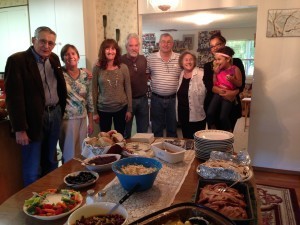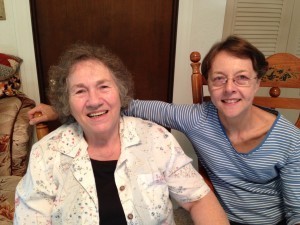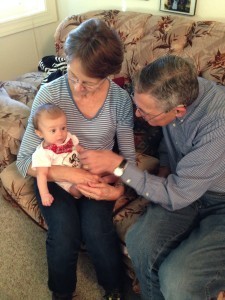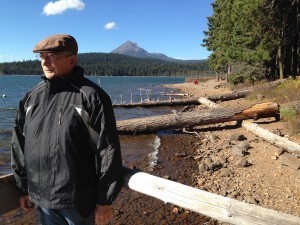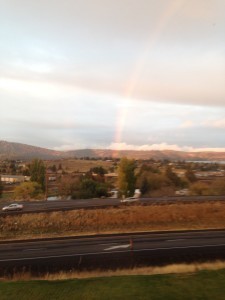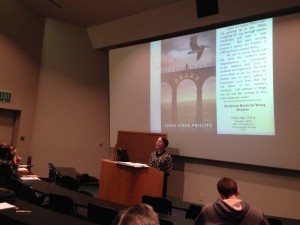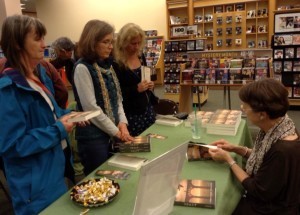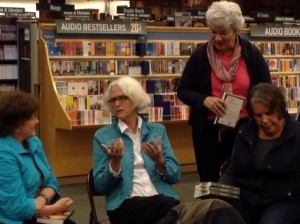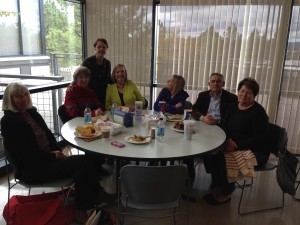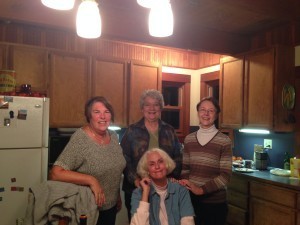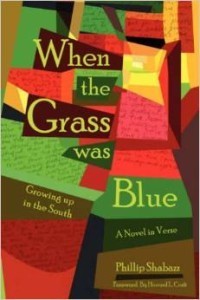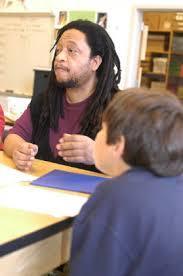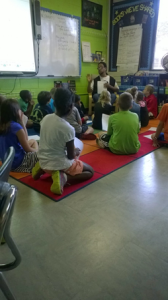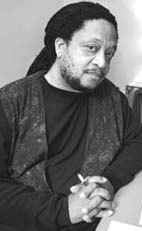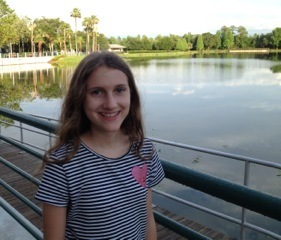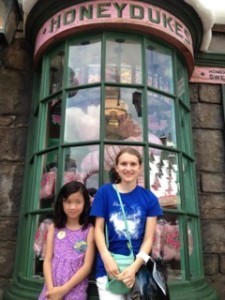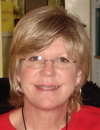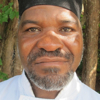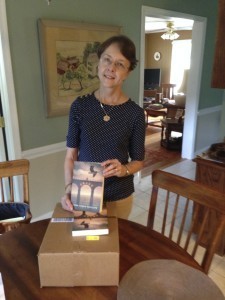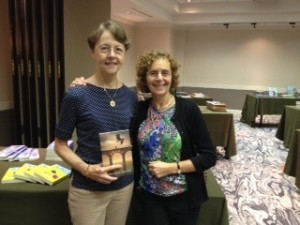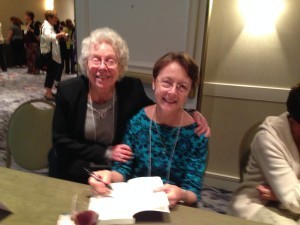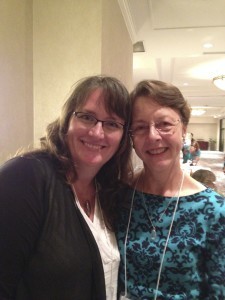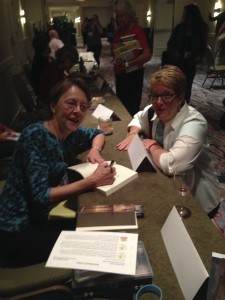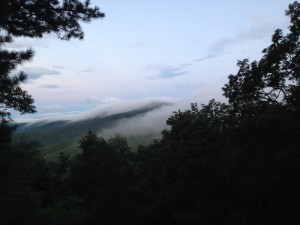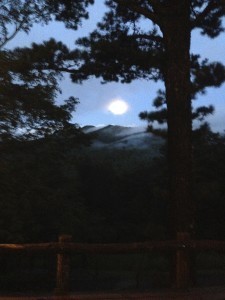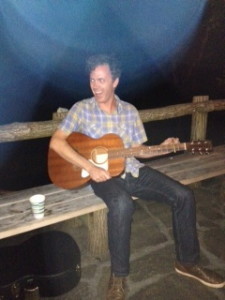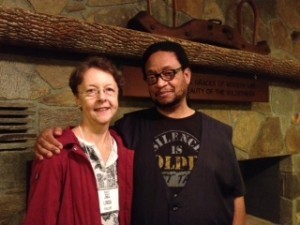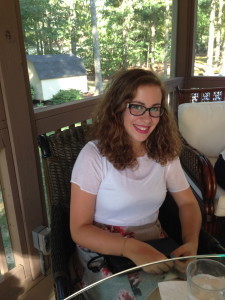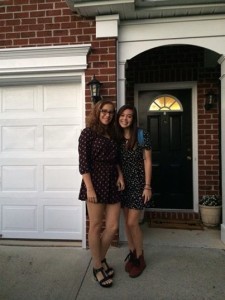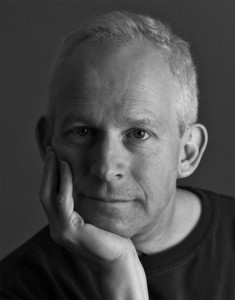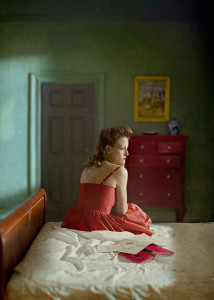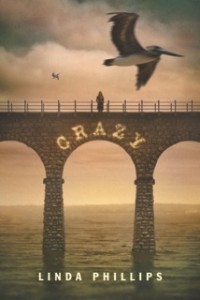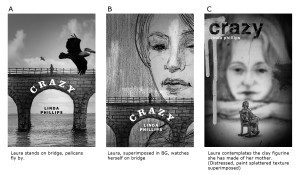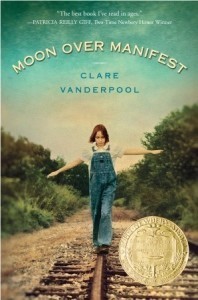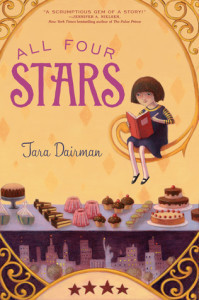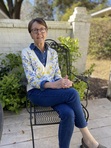Linda Vigen Phillips's Blog, page 5
October 27, 2014
THE LAUNCH TOUR
This whirlwind book launch tour is winding down, with two more events and a few days of R & R on the Oregon coast before heading home. What a learning and stretching experience it has been, so full of wonderful people and places!
Thanksgiving dinner in October with my wonderful western family!
A great reunion with my sister,
and meeting the newest member of the family, my great great niece!
We stopped at one of my favorite childhood places, Lake O’ the Woods, on the way to my hometown, Klamath Falls. Oregon is experiencing drought which is evident in this picture. My husband is standing where the water should be.
First morning out we had a rainbow out our motel window. Can you think of a better way to start?
Speaking to a Psychology 201 class in a large lecture hall was one of those “growing and stretching” moments, but I did it with God’s help!
Meeting so many lovely people at every stop along the way,
watching the dialogue take off,
and visiting lifelong friends!
Thanks to ALL my friends and family who have followed me and supported me along the way! Looking forward to the Charlotte launch on Nov. 8 at Park Road Books at 2:00!
**************
Congratulations to Glenda Blaisdell-Buck, winner of last week’s drawing for Phillip Shabazz’s wonderful book in verse, When the Grass Was Blue.
October 20, 2014
Part 2, Phillip Shabazz interview and a giveaway!
Last week Phillip Shabazz shared a bit about his family background and early life, and I’m pleased to have him back today to talk more specifically about his novel in verse, “When the Grass Was Blue.” If you leave a comment or indicate you will share on your favorite social media I will enter your name in the drawing.
Here is a synopsis:
Told through the eyes of a young boy, “When the Grass Was Blue” poetically portrays the trials and hardships of growing up in the South during the Civil Rights era of the 1960s.
On the surface, Kathoor, the youngest child in a working-class African American family from Louisville, Kentucky, appears sheltered in a stable home with his working father, faithful mother, and cool big brother. But as dysfunction in his family becomes apparent, Kathoor senses their familial closeness slipping away-and he feels as though he’s losing the most important people in his life. Trying to adjust, Kathoor’s only option is to search for strength within his own heart.
LP: Your novel in verse, When the Grass Was Blue, was widely used by language arts and social studies teachers in North Carolina schools. Tell us how you came to write it.
PS: I wrote When the Grass Was Blue, out of curiosity about that significant period of American history popularly known as the sixties. I wanted to draw attention to that time and place because I have an interest in the Civil Rights struggle and an interest in the idea of freedom. I’d read Dr. King, Malcolm X, and other activists from that era. I wanted to get a better understanding of what the Black Liberation Movement was all about.
What really interested me, during that era, is how people were choosing sides about various issues such as racial segregation, police brutality, poverty, the war in Vietnam, etc., and how all this impacted children in general (particularly black children), how all this impacted the black family and community. The questions I asked myself were, what is the fallout of all this? How did black people come through the fallout?
I decided to ground When the Grass Was Blue in that period because there were characters that I wanted to bring to life. The story focused on a family who endured the turbulent complexities of that moment. That family experienced the struggle of private and personal everyday matters, and at the same time, the public challenges, pressures, and concerns of a racially segregated society. So the result of my interest in When the Grass Was Blue, is a blend of family, community, and an unforgettable history.
LP: Many students have an automatic aversion to poetry, yet you have been very successful teaching it in the schools. Can you share a few anecdotes or methods of working with students?
PS: I try to meet students on common ground and relate to their world. I give them a number of guidelines and ideas to choose from, in addition to sample poems to reference. We discuss craft, in other words, what makes a poem imaginative and interesting. I ask them try to write about something that matters to them, something fun, or something heartfelt regarding an experience, a person, a time and place. I tell them to write what they think and feel. It always amazes me what the students come up with, how each of them uses words to create a new way of seeing or experiencing the world.
I did a reading with students in Richmond County, NC at a high school. It was like a new light covered the auditorium: teachers and students made a deep connection through poetry. There was laughter. People cried. They supported one another. Even the shyest and most underachieving students let it all out. That’s when I really saw that ‘the pen is mightier than the sword.’
LP: You have several works in progress. Can you tell us about what you are working on for young readers?
PS: I am trying to finish a novel for middle school students, which is attempting to show something about peer pressure and bullying from the point of view of a high school kid who looks back at that period of his life. What I’m trying to convey is how a specific reality (bullying) affects who we are, and who we become.
LP: As a retired teacher and a parent I can tell you that there is a definite need to address the topic of bullying in a way that reaches young people right where they live. I can’t wait to read this one! In closing, what nugget of wisdom would you like to share with writers, particularly those who dream of getting published someday?
PS: Whether it’s writing a song at the kitchen table or a story in a corral at the library, or a poem at the desk in your bedroom or study, writing in any of those places can work and leads to publishing, if you make that writing space you own. It’s like staking a claim: you mark your spot, and make your mark. Oh, and have a good time.
LP: Thank you, Phillip, for inspiring us with your work and words, and showing us how we can have “a good time” with writing at any age. READERS of all ages, leave a comment or indicate you shared on social media so you won’t miss out on the drawing for When the Grass Was Blue.
****************
Hey READERS, I would love to hear from you.
Is your MIND FULL of old thoughts or new?
October 13, 2014
Meet Phillip Shabazz, Poet, Author, Teaching Artist
In an earlier post (TABLE ROCK WRITERS WORKSHOP)I shared a bit of the wisdom that I gleaned from Phillip Shabazz’s poetry workshop at Table Rock. Today I am pleased to welcome Phillip to the first of a two-part interview, where he will shed more light on the makings of a poet and writer.
LP: Phillip, I know you have a very busy schedule, so I am thrilled you have taken the time to be here today. Tell us about your early years, where you grew up, siblings, family life, schooling, etc. How has that shaped your writing?
PS: I came of age in a housing project in Louisville, Kentucky. My mother, the head of the family, worked domestic jobs in the time of Jim Crow, when, as my oldest brother would say, black people got their heads cracked for speaking out against racial injustice. All of this was during the Civil Rights years, when the mainstream of American society was experiencing the 1960’s.
We were very poor, but from childhood, my life was always enriched by music at home, at church, and at school. In my family, music had a very special value. Our way of enjoying each other’s company, and communicating in the world was through music. It was all we really had. I learned to sing, not so much in church, but from the music I listened to on the radio, especially songs from the Temptations, Aretha Franklin, James Brown, and Curtis Mayfield, to mention a few. Early on, Soul and Jazz, Rock and Roll, and the Blues schooled me in the ways of American culture. Music was, in a special way, a picture of us, but with sound.
I didn’t look at the world through television but through the prism of a song, a novel, or a poem. This felt intuitively sincere. One way or another, through music, I became aware of language—stories and lyrics, as a way of communicating, and of constructing something out of my life. It was more an organic education than a formal schooling. And so from elementary school through high school, music is what I most valued. By the time I got to college at the University of Louisville, music and creative writing had already hit me. The short of it is music was my way into poetry and prose. It was a natural progression.
LP: When did you become interested in writing and at what point did you decide to make that your life work?
PS: I was always writing, where I could and when I could. I had stages of interest—rhymes when I was a boy, songwriting and journaling when I was a teenager, prose and poetry as an adult when I started engaging ideas for social change. I decided to make writing my life’s work while I was in college.
LP: You have been an artist-in-residence at Duke, you have taught creative writing workshops to both adults and children, and you have written books for both adults and children. Across all this diversity, is there a favorite, and if so, why?
PS: That’s a hard one . . . I have felt the necessity of working with various age groups all my professional life. Expression from writers at different phases of their development really interests me—children because they express what childhood is like; young adults because they show what happens during the years of adolescence, adults because they reveal what has happened to them on a personal and reflective level. They all express a certain kind of fleeting impermanence about the human journey. The truth is, I don’t have a favorite age group entirely, but on occasion, I’ll bond with a group of writers, and during that time it’s like being in seventh heaven.
LP: Thanks for these insights into the writing life, Phillip. Readers, stay tuned next week, when Phillip will talk about (and give away a copy of) his middle grade book in verse, “When the Grass Was Blue.”
****************
Hey READERS, I would love to hear from you.
Is your MIND FULL of old thoughts or new?
October 6, 2014
Meet Eliana, a Teen-acious Teen!
Today I am pleased to welcome another TEEN-ACIOUS teen, Eliana Franklin, who comes highly recommended by her mom, Miriam, a fellow author whose debut book, Extraordinary, will be released by Skypony Press in 2015. Eliana is already following in her mother’s footsteps by seriously pursuing her love of writing.
LP: Welcome, Eliana. Tell us a little about yourself.
EF: I am fifteen, in ninth grade, and I go to NorthWest School of the Arts as a Visual Art Major. I went to Lansdowne Elementary for elementary school and Charlotte Secondary for middle school. I have a sister named Carissa, who is adopted from China. I love that my family is very unique and loving and nice.
LP: I know you love to write and that love usually stems from a love of reading. What are your favorite reading interests?
EF: My favorite book genre is fantasy, though dystopian and science fiction is a close second. My favorite books are the Harry Potter series by J.K Rowling, the Percy Jackson series by Rick Riordan, Peter and the Starcatchers series by James Barry and Ridley Pearson, the Slated Trilogy by Teri Terry, the Divergent Trilogy by Veronica Roth, the Hunger Games Trilogy by Suzanne Collins, the Mysterious Benedict Society Trilogy by Trenton Lee Stewart, House of the Scorpion by Nancy Farmer, The Giver Quartet by Lois Lowry, and Eon and Eona by Alison Goodman.
I love these books because they are very intriguing and exciting, they have good characters, and they have meaning to them.
LP: That’s an impressive list. What is your favorite subject in school?
EF: My favorite subject in school is math and it has been my favorite subject since 6th grade.
LP: It sounds like you have a wide range of interests, and now I want to hear about the novel you are writing. Can you give us a synopsis of what it is about?
EF: It is called Alone Forever (Maybe). At the beginning, there are three girls: Breeze, Renna, and Tracie. Because of a past friendship, Breeze gets angry at Tracie, who had just now showed up after several years, and slams the door on her while at her house with Renna. Breeze has just made Tracie feel unwanted, and when someone feels unwanted, the evil Enola Fairies will come and take you away, and only a true friend can save you. Tracie is, in fact, taken away, and Renna and Breeze, with the help of the Guardians of Good, fairies that protect the seven Elements of Good, must go to Enoon, the Place of the Unwanted. Along the way, they meet Rachel, a girl who has to save her mom, Meena, and do much, much more than they sought out to do in the first place.
I’m also working on another book called The Spirits of the Universe, about a girl who must go on a mission to save the world, because of a prophecy about her.
LP: It sounds like you have already put a lot of thought and effort into both pieces. When did you start writing and where do you get your ideas?
EF: I started writing Alone Forever (Maybe) when I was in sixth grade. I was actually only planning on writing a short moral advice scenario, where it shows the right thing and the wrong thing to do, but that scenario somehow turned into the first chapter of the book. I also got the idea of the fairies from this other book that is about evil fairies, though I didn’t really like or finish that book. I got the Elements of Good from a short story I wrote in seventh grade, and some parts of the book go hand in hand with my other book, Spirits of the Universe.
I got the ideas for Spirits of the Universe from reading a lot of books about people with specific magical powers, such as Percy Jackson by Rick Riordan or Charlie Bone by Jenny Nimmo. In both books, I got ideas for characters from the people around me, such as Meena sort of being based off my mom, and Renna being based off my friend.
LP: So its easy to see that all your reading really enriches what you write. When do you find time in your busy school schedule to write? Have you shared your writing with any of your friends, teachers, or family?
EF: I work on my books whenever I get the chance, hopefully for at least an hour on the days I’m not busy! I have showed some of Alone Forever (Maybe) to my mom, and have showed Spirits of the Universe to my mom, dad, friend, and teacher last year. However, I don’t think my teacher actually read it.
LP: You are lucky to have family and friends who are willing to read your work, and a built-in editor in your mom. What do you plan to do with the novel(s) when you are finished? Do you dream about getting published one day?
EF: I actually just completed Alone Forever (Maybe), and it is about 57,000 words right now. I plan to print it off and show it to people, and I would like to get advice from my mom, teachers, or friends. Someday in the future I would like to get it published, though someday later when I’m older and a better writer. Then, I can go back through it and try to get it published.
LP: It sounds like you are way ahead of many adult writers I know, and I won’t be at all surprised to see your name in print someday! One last point of interest. I noticed that part of your email sign-off says “be vegetarian.” I’m thinking this might be one reason why you said earlier that your family is “unique.” Can you tell us a little about it?
EF: My parents were vegetarian before I was born, so I’ve been a vegetarian all my life. The whole family is vegetarian because we believe it is cruel to kill and eat animals, especially with factory farming. There are no difficult challenges in this diet because we make sure we have healthy meals. We get our protein from things such as veggie meat (made with soy), tofu, tempeh, edamame, hummus, and other stuff like that. We also eat a lot of vegetables!
LP: Thanks for sharing your thoughts with us today, Eliana and giving us a peek preview of your work. I wish you every success as you continue your journey in the creative arts. READERS, Eliana would love to hear from you and respond to your questions or comments here!
Carissa and Eliana
September 29, 2014
Writer’s Day Off: FRIENDSHIP TRAYS
What do writers do when they aren’t writing? I don’t know about other writers, but I know I need to get away from it once in a while, and I’ve found the perfect escape. Every Thursday morning I spend a little over two hours dishing up food for those in our community who “are unable to obtain or prepare their own meals because of age or infirmity.”
I’m talking about the meals-on-wheels program in Charlotte, better known as Friendship Trays. This invaluable organization, headed by former volunteer Lucy Bush Carter, delivers more than 600 meals daily to those who are elderly, disabled, convalescing or otherwise unable to prepare meals on a regular basis. Those of us on the assembly line prepare two trays for them: one consisting of a salad, fruit and bread, and the other a main course of meat or fish and vegetables. The trays are separated and labeled according to dietary needs and destination, and delivered near noontime by volunteer drivers to anyone who has requested or been recommended to receive the service.
I can tell you first hand, these meals are prepared with lots of love and much behind-the-scenes activity. Much of the food these days is grown in Friendship Gardens, a joint initiative of Slow Food Charlotte and Friendship Trays. Many of us have gotten to know Lani Lawrence, Volunteer Coordinator, who has the difficult task of making sure just the right number of volunteers are available on a given day. Long before we arrive, Head Chef, Lamont Harrison and Sous Chef, Devonne Jackson are hard at work. When we roll in a little before eight, it is not uncommon to get a huge hug or a heartfelt greeting from Kitchen Manager, Tammy Curry or Dietary Manager, Jennifer Wahab.
Lucy Bush Carter Tammy Curry Lani Lawrence Devonne Jackson Lamont Harrison
On Thursdays there are about seven or eight of us who come on a pretty regular basis. We’ve gained the reputation as “the divas” (not sure if that’s good or bad but I can tell you, we take our work seriously!) You can see for yourself in the clip below:
Friendship Trays Video Clip
Sometimes we are joined by students or other organizations, and unflappable Tammy and Jennifer choreograph the scene like master magicians, making it a meaningful and productive experience for all. Frankly, their management skills are on a par with their culinary skills!
If you are unfamiliar with this organization, I urge you to check out their website and get involved in a way that is comfortable for you. BTW, this is an unsolicited, from the heart promotion of my favorite nonprofit organization. In my opinion they are doing everything right, not only feeding the hungry, but feeding them well and with a big heart. Through my tiny moment of connection with them each week I have gained great new friends and broadened my horizons.
****************
Hey READERS, I would love to hear from you.
Is your MIND FULL of old thoughts or new?
September 22, 2014
SCBWI-Carolinas 2014 and first signing of CRAZY
The 2014 SCBWI-Carolinas conference was for me, a story within a story. First, the inside story. CRAZY was scheduled to be in the warehouse somewhere around Sept. 20, and the SCBWI conference started Sept. 19. Oh heartbreak, I thought. I am going to miss signing my book at an SCBWI conference by a hair and I will have to wait a whole year. But then I began to think of the “what ifs” like authors tend to do. What if the book arrives early, and I can somehow get it here in time for the Saturday night signing? What if I start bugging SCBWI on this end, and Eerdmans on that end to see if things can’t be adjusted just a wee bit to accommodate my little heart’s desire? What if it IS in the warehouse but FedEx can’t get it here in time and I hire a drone to pick up and deliver it like lickety-split, voila, at your service ma’am?
Well, long story short, I didn’t have to hire a drone. It was in the warehouse on the 19th and Eerdmans was able to get it to my house by 4:00 pm on Friday afternoon
and SCBWI was kind enough to let me slip it in just ten minutes before the book store closed (after a speed-breaking ride to the hotel). Whew! My thanks to Jenny Holt at SCBWI and Vicki at Quail Ridge Books for making it all happen.
And part of the fun was celebrating this event with my long-time writing buddy Carol Baldwin who rightfully calls herself the “Aunt” of the book, since it was her idea to turn twenty poems into a novel way back when.
And then there was the signing. House guest and good friend Gloria Glenn bought the first copy,
and Kami Kinard, author of THE BOY PROJECT and THE BOY PROBLEM, sat next to me and graciously shared the mysterious wisdom of signings while I tried to ignore the fact that her line was longer than mine! (No problem, Kami, I will credit you with toughening my skin early on, ha!)
And then Emma Dryden, THE Emma Dryden of Dryden Books, whose Master Class I was enrolled in and who happens to be one of the people in the book industry whom I most admire, showed up in my line. Needless to say, my first signing exceeded all expectations.
And about the other story, that is, the Master Class that I was enrolled in–I have nothing but wonderful praise. First, to SCBWI for realizing, after all these years, that published authors have a different set of needs on the learning curve than do those who are just starting out. And to Emma, who helped us build worlds we never imagined, characters who yearn to be interviewed, and stories that demand to be revised in unique and refreshing ways.
Carrie Ryan‘s closing keynote just hit the nail on the head. Her presentation chronicling her own writing history was snappy, funny, and totally relevant. But what I loved most was the cadenced repetition woven into her spiel: writers write. Sounds simple enough, but boy, on days like today when you are re-entering reality after a weekend of hard work on the craft, it’s a tall order.
Now, if you’ll excuse me……
****************
Hey READERS, I would love to hear from you.
Is your MIND FULL of old thoughts or new?
September 15, 2014
TABLE ROCK WRITERS WORKSHOP
Phillip Shabazz, Poet
Phillip Shabazz is a poet, author, and teaching artist whose work explores issues of community and culture in America. In 1997 he became Duke University’s third artist-in-residence at the Mary Lou Williams Center for Black Culture. During his four year residency he was a founding member of SpiritHouse, a community service organization and he organized a student art collective and a twice-monthly speaker’s series that presented local and nationally known poets and writers. He has taught creative writing workshops at more than 300 schools, conferences and community centers. He is currently a poet-in-the-schools in his home state of North Carolina, and his latest collection of work is Flames in the Fire: Poems.
If you’ve ever been to the mountain top where the air is rarified and where thoughts crystalize with an ease not found in common hours, then you know what it’s like to come down and return to the land of laundry, groceries, and bills. Last week I was literally on the mountain top at WildAcres retreat near Little Switzerland (3500 feet), attending the Table Rock Writers Workshop, soaking up wisdom and beauty in big gulps.
I was privileged to attend Phillip Shabazz’s “Powers of Poetry” workshop with four amazing individuals, and to mingle with approximately fifty other writers and musicians over meals, concerts, readings and presentations (and of course, the happy hours!)
John Bemis after-hours
Whew! I know you can’t stay on the mountain forever,and in fact, the beauty and effectiveness of such experiences is enhanced by the intensity crammed into a brief span of time. But as I slowly re-enter the realities of life , I’m reminded once again how powerful and invaluable mountain top moments are to the creative process, and I am extremely thankful that such opportunities exist right here in North Carolina.
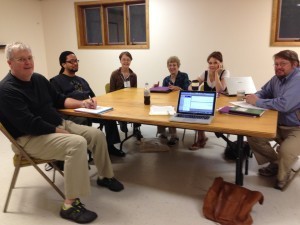
Every morning a TV anchorman, a retired professor of social work, a district court judge, a visual artist and I gathered for over three hours of poetry immersion. What a motley crew we were! We started by each sharing something we had written, and after the first night, it was often the result of an assignment from the previous day. We didn’t have a lot of time to spare in the afternoon, so working on a daily assignment along with taking in all the beauty and managing a bit of socializing was a gargantuan task.
Phillip has an amazing ability to make work seem like child’s play, and he DID work us. Over the course of the week,here are some of the assignments (accompanied by written and discussed definitions of these words)
1) theme: Write a poem that invokes your family or friends or a side of yourself. Try using a variety of corresponding images with similar, but diverse features, real or imagined that call up strong emotions and which may have had consequences in your life.
2) connections: Make a bittersweet connection in your poem to one of the following–a spiritual idea, a force in nature, a manmade object, or a personal space.
3) scene: Ground your poem in a place. Show how the place parallels another place, time, and situation to throw light upon the meaning of the experience.
4) structure: Consider writing a poem with a rhyme scheme (the Villanelle) or compose a poem using key word repetition, with no particular placement of the key words, in order to secure emphasis.
That last one caused some of us (self included) to sweat bullets. If you’ve never tried a villanelle (nineteen-line poem consisting of a very specific rhyming scheme, each line having 8 syllables, and the first and third lines in the first stanza are repeated in alternating order throughout the poem, and appear together in the last couplet) you are in for a sweaty good time, for sure!! And if you can picture a district court judge writing something that starts with “come to my villa, Nell” then you have a taste of the humor that lived at our table all week.
In between laughs, we peeled the onion raw and shared unashamed tears: a newscaster not reporting, but reliving the terror of a tornado; a social work professor standing on the soil of a concentration camp; a visual artist caught in her mother’s racial prejudice; a writer facing raw family issues.
Along the course of the week, we dipped into some of the greats: Hayden Carruth, Charles Bukowski, Anne Sexton, Sylvia Plath, Allen Ginsberg, Ted Kooser, Ysef Komunyakaa, James Wright, Carolyn Kizer. Some were new to me and some very familiar, and all were fascinating to read and learn from.
I feel like I touched the tip of the iceberg with one of the most capable tour-guides around, and I came away hungry to dig deeper. I can’t say enough nice things about Phillip Shabazz, the Table Rock Writers Workshop, or my four new friends with whom I bore my soul and for whom I have the utmost respect for doing the same with me.
****************
Hey READERS, I would love to hear from you.
Is your MIND FULL of old thoughts or new?
September 8, 2014
Meet Justine, a foreign exchange student from France
Justine Le Page
Last month I interviewed Penelope Chirolde, the first TEEN-ACIOUS teen to appear on my blog to talk about a few activities she is involved in. One of the things she mentioned was the pending arrival of Justine Le Page, an exchange student from France who will attend Providence and live with the Chiroldes this school year. Penelope and I both thought Justine would be a great candidate for an interview, so I am pleased to have her here today. (If you are interested in becoming an exchange student or hosting one, you can check them out at PAX.org.)
LP: Hi Justine, and welcome to America. I hope your introduction to our country has gone well. Tell us a little about yourself and your family.
J: I come from a small village, Montigny-l’ Allier(272 inhabitants), outside of Paris. I have an older step-sister and step-brother who do not live at home. My dad is a business owner and mom was a medical scientist, but she quit work when I was born.
LP: I understand you were in the states last summer with the French organization SILC (School of International Letters and Cultures) https://silc.asu.edu/ whose goal is to “provide students with a variety of educational experiences that prepare them for life and citizenship in the modern world.” Tell us about that.
J: Yes, last summer I stayed in Washington, DC for three weeks. I took courses in the morning and toured around the area to see such things as the White House and the Capitol building in the afternoons. My parents and I also went to New York City where we saw the play “Chicago” and did a lot of shopping, too, at places like Victoria’s Secret, Hollisters and Abercrombie and Fitch.
LP: Tell us how you became interested in coming to America as an exchange student? Was it something you always wanted to do, or an idea that you recently started pursuing?
J: I was interested in becoming an exchange student since I was in the ninth grade, but of course I was too young then. I just signed up this past year, which was my sophomore year.
LP: What classes are you taking, and are you and Penelope taking any classes together?
J: None of my classes will transfer when I get home, so I will repeat my Junior year. Here I am taking two Junior classes, Honors English and American History, and three Senior classes, Swimming, Principles of Business and Finance, and Theater. I don’t have to take Math or Science since I am an exchange student (yeah!) Penelope and I don’t share any classes but we eat lunch together.
LP: How does our class structure differ from yours?
J: In France you choose from several tracks—Economics, Literature, or Science—and I have already chosen Economics. I am particularly interested in politics and journalism within that category.
LP: You’ve only been here a couple of weeks. What are your first impressions?
J: Providence is much bigger than my school in France. There my friends and I knew each other a long time because we grew up together. I notice that there are social groups or cliques here, but I have felt welcomed. The teachers here seem very nice and more caring or personable than my teachers in France. The teachers here seem like they want to help more than the teachers at home. The dress code and cell phone use is stricter here than it was in France.
LP: What genre do you like to read? Do you have a favorite author or two?
J: I read Hunger Games and saw the movie and I also read and saw The Fault in Our Stars. At home my favorite author is Guillaume Musso, who is a very popular author of psychological fiction in France.
LP: Have you given some thought to colleges and possible careers?
J: I am interested in going to Columbia University or NYU and studying journalism, possibly pursuing news reporting. I am also interested in becoming involved in politics someday, maybe even holding an elected office.
LP: What do you hope to gain from this year in America?
J: I really hope to learn to speak English better. At home my mother used to speak some English and my dad didn’t speak it at all. Mostly I have been motivated on my own to learn it because of my interests in journalism and business. I hope I can mature through this year and realize some new things about life.
LP: Thanks for giving us your thoughts, Justine. It sounds like your school year here has gotten off to a great start and I wish you every success in your future academic career.
Justine and Penelope
****************
Hey READERS, I would love to hear from you.
Is your MIND FULL of old thoughts or new?
September 1, 2014
Meet Richard Tuschman, cover artist for CRAZY
Today I am extremely thrilled and honored to introduce to you the cover artist of Crazy, Richard Tuschman, who has graciously taken time out from his busy schedule to answer a few questions.
LP: Welcome, Richard! Tell us a little about yourself and how you came to choose a career in art.
RT: I grew up in the 1960’s in a leafy suburb of Cleveland, Ohio. Perhaps not surprisingly, as a child I liked to draw a lot, at first mostly sports heroes, then later as a teenager, pretty embarrassing portraits of rock musicians. I also loved looking through my parents’ and grandparents’ photo albums. Perhaps this explains my strong connection to the early-mid twentieth century time period. My father was a businessman, and though my mom took up painting later in life, as a child I did not have any “art” role models. I was fortunate to have a high school art teacher who was very encouraging, and by the time I entered college at the University of Michigan in 1974, I knew I wanted to spend my life making art. I spent one semester in Liberal Arts, after which I transferred to the art school there, and that was it.
LP: When I first peeked on your website shortly after Eerdmans told me you would be doing my cover, I was ecstatic to see your Hopper Meditations because, as you know, I mention Hopper in my book and he happens to be one of my all-time favorites. I’ve been dying to know if that was a fluke, or if it had any effect on your selection to do my book jacket.
RT: While the reference to Hopper certainly did not hurt, I would have wanted to work on the jacket anyway, because I loved the story. But the fact that you love Hopper, as I do, probably means that we both see things a certain way. Though his pictures are very quiet and understated, there is a lot of emotion and humanity just beneath the surface. I would imagine you would more or less agree with that.
LP: You use digital imaging in your Hopper Meditations and in much of your work. Tell us about the process involved.
RT: Let me give you a little history first. I have always been interested in blending photography with other media. When I was in art school, before there were computers, I did a lot of photo-etching and photo lithography. I also did a lot of mixed media pieces that combined painting and photography. One of my first jobs when I moved to New York, after art school, was working in an architectural supply store. Inspired by the model-making materials there, I began making small diorama constructions that resembled miniature stage sets. They also made use of painting and collage. By the late 1980s I was supporting myself as a graphic designer, creating print promotions for HBO. It was there that I was introduced to computer graphics and the Macintosh. When the first version of Photoshop was introduced in 1990, it changed my life. Right away, I loved that I could seamlessly blend scanned painted textures, personal photographs, and all manner of found scraps and printed materials, with complete control over opacity, contrast, and color.
I quickly developed a working method that felt very analogous to painting and printmaking. Instead of applying layer upon layer of paint, I am continually adding and re-working layers of images, colors, and textures; trying different opacities and blending strategies. I use a stylus and a pressure sensitive tablet so it feels very intuitive.
For the Hopper series, the majority of my time is spent building and photographing the physical miniature sets, as opposed to trying to create them in Photoshop. Still, the end result would be impossible without the control and flexibility that the digital process offers. The sequence goes like this: first I build the diorama to nail down the setting and the light source in the scene (usually window light), so that I know how to pose and light the live model. Then I will photograph the live model. This usually takes a full day, with lots of posing and lighting variations, along with a few wardrobe changes. This way I have some options, and enough raw material for several montages. Next, I will photograph the diorama, doing the best I can to match the lighting to that of the live model photos. I use little wood mannequins as stand-ins for the live models which makes the job easier. Once I think I have the lighting right, I will remove the mannequin so that I have an empty room, properly lit, in which to insert the image of the live model in Photoshop. Photoshop gives amazing control when I blend the live model with the miniature room, so that I can exactly match the sharpness, grain, color, and contrast convincingly. I will also retouch some of the seams and imperfections in the diorama, play with the colors, and carefully paint the necessary shadows.
LP: Did you use a form of digital imaging on Crazy, or a totally different process? And I know how many revisions I’ve done as the author. Did you hit upon the present image right away, or were there many preliminary sketches before deciding which way to go?
RT: For the Crazy cover, I actually used the same method as for the Hopper images, combining a miniature table top scene with a live model, along with a couple of existing photos. The bridge is a railroad model I purchased and painted, and the water I made with acrylic glossy medium and paint. The pelican is a stock photo, and the sky is from my personal archive. The girl I photographed in my studio, then I put everything together in Photoshop. I did a bunch of sketches, but I always liked this one best. I love working on projects that need to convey some emotional weight, so as you might imagine, I really loved working on this! (Note: click on picture to zoom in).
LP: What is the first step in the process of matching an illustrator to an author’s work? Do you read the book and decide whether to take it on or turn it down, or are you hired and then assigned the book?
RT: As with the Crazy cover, it is usually the publisher’s art director who will approach the illustrator who’s style they think is a good match for the project. In my experience, their instincts are usually on target, and I rarely turn jobs down because I think they are a bad fit, though it happens occasionally. I will base my decision on the art director’s brief, but after I have accepted the job, I always prefer to read the manuscript if it is available, because I really want to immerse myself in the subject matter. Unfortunately, many times the manuscript is not available for the artist to read, so I only have a synopsis and some provided reference. I think this puts everyone at a disadvantage, because then it becomes a bit of a hit-or-miss guessing game.
LP: I’ve always been mystified about why the author and illustrator are not “invited” to discuss the cover. As the illustrator, what benefits and/or drawbacks would you envision if you had an option to have the author’s input. You won’t hurt my feelings either way!
RT: On almost all of the covers I work on the authors have some degree of input, and sometimes the right to approve or reject, and I think this is fair. I always want the author to be happy, because I want to think of the finished work as a collaboration, and I like to think of my work as serving the author’s purpose, rather than just pretty packaging to sell a product. That said, in terms of process, it probably is best that in most cases the art director acts as the intermediary, since it is he or she who is responsible for tying all of the visuals together.
LP: I have a confession to make. I was confused when I first saw the cover, because it was not the bridge I have in my head, which is based on a real bridge. Then after it was explained to me that it was a conceptual bridge, I was in awe of that brilliant idea and totally in love with it (as have been many others!) Did Eerdmans “encourage” a conceptual picture or was that totally your interpretation?
RT: Eerdmans gave me total freedom, which is how I most like to work. Usually there is a good preliminary discussion just to make sure I am not headed off in the wrong direction, but I take responsibility for the “conceptual” bridge. Truth be told, in this case they probably did a better job of selling you on the “conceptual” bridge than I would have. Had I known you envisioned a different bridge, I probably would have tried to create that bridge. But I like this bridge, especially the way the title works with the arch. I also wanted a bridge where you could see some details of the girl, the bridge itself, and the water below.
LP: You’ve done a number of book covers, including the 2011 Newbery winner, Moon Over Manifest. I’m sure that one stands out in your mind as a favorite. Can you share a little about that process?
RT: It is funny you should mention that cover, because that is one of my favorites, and the process for that image was very different from what I have just been describing. The publisher, Random House, knew exactly what they wanted on that cover (the 12 year old protagonist walking down a railroad track), so I had very little freedom, I suppose. But in this case it did not feel at all stifling, because even if I had not been assigned that cover, it is an image I would have wanted to make anyway. Also, in relation to a lot of my other work, there is very little digital manipulation involved, mostly just some subtle textures and color enhancement to the original photograph. I was fortunate to have found the perfect 12 year old model, who was the daughter of friends of mine. I remember one of the most time consuming parts of that project was “distressing” the brand new overalls so that they looked sufficiently “depression-era” worn. The story took place in Kansas, and at the time of the assignment I was living in Florida, where I took the photograph. Fortunately, Florida was flat enough to be a convincing stand-in, though I think I had to digitally remove a palm tree or two.
LP: You don’t just do book covers. Can you tell us a little about some of your other projects?
RT: I am working on a new series that is set in Poland during the late 1920s to early ’30s, pre-World War II, pre-Holocaust. The architecture there, and some family history, really inspired me. Kraków, the city where my wife grew up, survived World War II intact. It is a beautiful old city, and many of the buildings are from the Renaissance period or even much earlier than that.
This series uses the same “diorama” technique as the Hopper series, but I’m hoping to imply a more connected narrative from image to image, though still ultimately open ended. It will also feature an expanded cast of characters.
LP: I know that I have a whole new appreciation of book covers and their creators, and as a debut author, I could not be more thrilled to be able to say Richard Tuschman did my cover. Thank you, Richard!
+++++++++++++++++
Congratulations to Miriam Franklin who won the drawing for the swag packet from Tara Dairman, author of All Four Stars, featured on last week’s blog.
August 25, 2014
Review of All Four Stars by Tara Dairman and a giveaway!
I can’t stop licking my lips over the most delicious middle grade novel I’ve read in a long while. It should get at least four stars. As a matter of fact, it IS All Four Stars (Penguin/July 2014) by Tara Dairman, and you’ll want to read it on a full stomach, lest you wear out your salivary glands before finishing it.
BTW, Tara has offered to give away a surprise swag packet to the winner of a drawing. Your name goes in the hat once if you leave a comment and twice if you tell me you are sharing on the social media of your choice.
Gladys Gatsby is an odd duck from the get-go. How many sixth-grade girls do you know who could successfully ignite their parents’ kitchen curtains while putting the finishing touches on crème brulee with a blow torch and live to tell about it?
Unfortunately, Gladys’s culinary giftedness is lost on take-out-food parents, and Gladys finds she has cooked her own goose as far as kitchen privileges go in the first few pages of her would-be culinary career. She earns a grounded-from-the-kitchen status, which she takes in stride along with her generally ignored position among her classmates.
When Gladys’s teacher encourages her to write about her desired future career for an essay contest sponsored by the New York Standard newspaper (think New York Times) Gladys feels sure no one will believe her true desire to become a food critic so she writes about becoming a veterinarian. Her teacher sees right through the “lack of passion” and gives her instructions to write what she truly desires to be in a letter form, as if she were applying for a job as a food critic. Through a hilarious chain of events, Gladys’s letter ends up on the desk of the real food critic, and there just happens to be an opening for which Gladys might qualify.
Along the way Gladys finds a true-blue friend in her next-door neighbor, Sandy, who offers support and technical advice, and irony of ironies, the sixth grade devious diva, Charissa, unwittingly provides the opportunity Gladys needs to prove she is, indeed, a four-star food critic worthy of the New York Standard.
Middle grade boys and girls, foodies or not, will howl over the ingenious names, antics and recipes mentioned along Gladys’s journey. Dairman has created middle grade personalities that more than fill the bill while providing their own quirky traits. I highly recommend this book to middle grade students while issuing a warning to parents: watch out what you feed your children. You may end up in a scathing review someday!
****************
Hey READERS, I would love to hear from you.
Is your MIND FULL of old thoughts or new?

